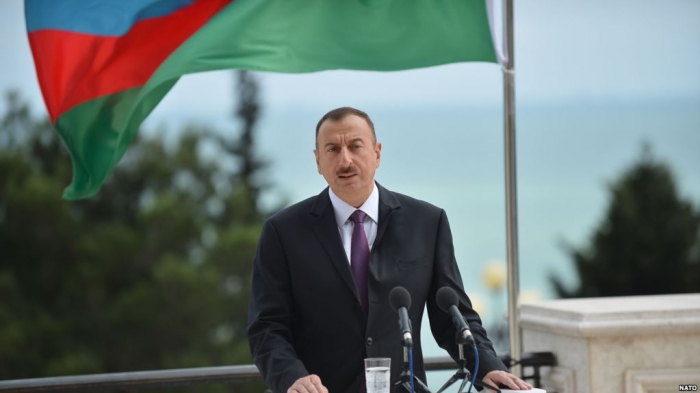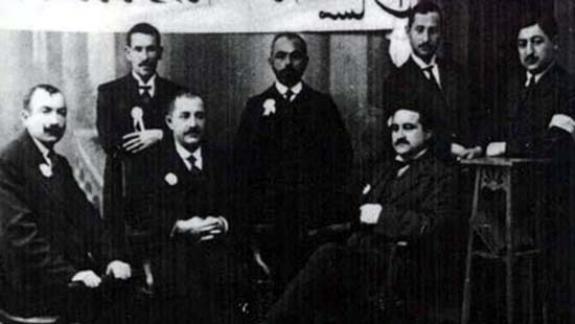The period of the Democratic Republic, 1918-1920, was a distorted and scarce mentioned page in the history of Azerbaijan during the Soviet era. As archive documents on this period were always kept closed, researchers could not find out the real history, and those who did know about it deliberately described it as anti-national. However, after Azerbaijan restored its independence, the "secret" and "top secret" archives were opened and a completely different view emerged. The new point of view is based on the history of the republic. The history that was slandered in the Soviet period turned out to be a proud and honorable one.
The announcement of 2018 as the Year of the Azerbaijan Democratic Republic is of great importance for the Azerbaijani people, state and society. The state established a century ago played an important role in the recognition of modern Azerbaijan as a democratic republic all over the world.
Despite the fact that the Azerbaijan Democratic Republic did not last long, it was at that time that the foundations of the Azerbaijani statehood were laid, which became a solid foundation for the construction of modern Azerbaijan after the restoration of its independence in 1991.
This first secular state in the Islamic world was proclaimed on May 28, 1918. This year Azerbaijan will mark the 100th anniversary of its creation. At the Cabinet meeting of Azerbaijan, the year 2018 was announced by President Ilham Aliyev as the Year of the Azerbaijan Democratic Republic. During the whole year, solemn events will take place not only in the country, but also abroad "The creation of the Azerbaijan Democratic Republic and its activities for two years was a historic event, Azerbaijan is a country that not only declared high democratic values 100 years ago, but also applied them. Today's independent Azerbaijan is the successor of the Azerbaijan Democratic Republic. We are loyal to all democratic traditions of ADR and we are putting them into practice. However, I should also note that the current Azerbaijan could not be compared with the Azerbaijan Democratic Republic, because at that time there were difficulties, that independence did not allow Azerbaijan to pursue an independent policy. We had economic difficulties and land losses; our ancient city of Irevan was given to Armenia. Therefore, we should very correctly analyze the activities of ADRs. We must not hide the positive and difficult moments. However, despite all the difficulties and the transfer of Irevan to Armenia, which is an unhealing wound for us, the Azerbaijani state and people highly appreciate the activities of the Azerbaijani Democratic Republic, - President Ilham Aliyev said. The establishment of Democratic Republic of Azerbaijan on May 28, 1918 was a historic event and one of the glorious pages in Azerbaijan history. In February 1917, monarchic regime in Russia was overthrown. The Provisional Government that replaced the monarchy held elections to the Constituent Assembly. However the Provisional Government was quite short-lived. In October 1917 coup d'etat occurred. As a result the members of parliament to the Russian Constituent Assembly from the Southern Caucasus could not go Russia. Instead on February 14, 1918, in Tiflis they founded the Supreme Power of the Transcaucasia the Transcaucasian Seym - the Transcaucasian Parliament.The Muslim faction of the Seym comprised 44 delegates elected to the Constituent Assembly from the region. Altogether they represented more than a million Turko-Muslim residents of Azerbaijan and the whole Southern Caucasus. In fact, the Moslem faction or the Council of Moslems was executing the functions of the Moslem Parliament of Transcaucasia. Like in the case of the Russian Dumas, the Azerbaijanian representatives were among the most consistent members of the Transcaucasian Seym. It was following their insistent claims that the Transcaucasian Seym proclaimed independence of the Transcaucasia on April 9, 1918. This indicated the foundation of the United Republic of Transcaucasia. However serious contradictions and conflicts of the national interests hampered abilities of both the Transcaucasian Seym and the Republic of Transcaucasia to undertake any specific steps. Finally, on May 25, 1918 the Georgian delegation left the Seym and proclaimed the independence of Georgia on May 26. On May 27, 1918, members of the Muslim Faction, i.e. of the Council of Moslems of Transcaucasia also held a separate meeting and decided to pass a decision to proclaim independence of Azerbaijan. With this purpose the Transcaucasian Moslem Council proclaimed itself the National Council of Azerbaijan, precisely speaking the Parliament of Azerbaijan. This actually indicated formation of the first Parliament in Azerbaijan and foundation of the first parliamentary republic was laid. During that meeting Presidium and chairman of the National Council of Azerbaijan were elected with M.A.Rasulzadeh becoming the first chairman of the National Council. A historic meeting of the national Council of Azerbaijan chaired by Hassan bay Aghayev was held on May 28, 1918. The meeting adopted the Declaration of Independence of Azerbaijan. Participants of the meeting were as follows: Hassan bay Aghayev, the Chairman, Mustafa Mahmudov, the Secretary, Fatali khan Khoyski, Khalil bay Khasmammadov, Nasib bay Yusifbayli, Mir Hidayat Seyyidov, Nariman bay Narimanbayov, Heybat Gulu Mammadbayov, Mehdi bay Hajinski, Ali Asgar bay Mahmudbayov, Asian bay Qardashov, Sultan Majid Ganizade, Akbar agha Sheykhulislamov, Mehdi bay Hajibababayov, Mammad Yusif Jafarov, Khudadat bay Melikaslanov, Rahim bay Vekilov, Hamid bay Shatahtinski, Firudin bay Kocharlinski, Jamo bay Hajinski, Shafi bay Rustambayov, Khosrov Pasha bay Sultanov, Jafar Akhundov, Mahammad Maharramov, Javad Malik-Yeganov, Haji Molla Salim Akhundzade. After the proclamation of ADR in a short time, the country's borders have been defined. The territory of Azerbaijan Democratic Republic is spoken about the first time in the Declaration of Independence. The document says that Azerbaijan located in the south and east Trans-Caucasus is an independent state. The Declaration of Independence of the Azerbaijan Democratic Republic stated that the lands of Northern Azerbaijan, once occupied by Russia in accordance with the Gulistan (1813) and Turkmenchay (1828) agreements are the legal heritage of Azerbaijani people. The first article of the declaration read: "Beginning from this day the people of Azerbaijan will have their sovereign rights. Azerbaijan, that consists of Eastern and Southern Transcaucasia, is a legal independent state". The Azerbaijan Democratic Republic issued its politically and legally substantiated map. It tried to spread its power on the entire historical area of Karabakh. At that time the newly established Republic of Armenia laid its groundless claims to Karabakh, but the government of the Azerbaijan Democratic Republic opposed these claims. During the talks with the Foreign Minister of the Ottoman state in Istanbul, November 18th 1918, A.M.Topchubashov (1862-1934), the chair of the Parliament of the Azerbaijan Democratic Republic said: "The Karabakh issue raised by Armenians does not concern only 5 or 10 villages, it covers all four districts: Shusha, Djavanshir, Djebrail and Zangezur. This territory belongs to only one nation and even though the number of Moslems and Armenians is not equal, there is no reason to talk in terms of domination of Armenians, because they are not native residents of these areas. These are those moving to the region from Turkey after the war with Russia…Finally, Armenians do not live separately in Karabakh itself, they form mixed settlements with Azerbaijanis. Nevertheless, we stand for the peaceful settlement of the problem". 


Armenians continued previously committed acts of genocide for the occupation of Karabakh in the period of the Azerbaijan Democratic Republic as well. Taking into account the established situation, the government of Azerbaijan created a Karabakh governorship-general dealing with the accidents in Shusha, Djavanshir, Djebrail and Zangezur in January, 1919 and appointed Kh.Sultanov the governor-general of Karabakh. The Foreign Minister of Armenia expressed his discontent with the establishment of the governorship-general, yet the response of Azerbaijani government considered the protest to be baseless and stated that these areas are the integral part of the Azerbaijan Republic. Karabakh governorship-general had to carry out its activity in conditions of the struggle against Armenia's claims and the tense relations first with Englishmen and then with Americans. However, Armenians did not give a chance to establish peace in the region of Karabakh governorship-general.
The National Council decided to form a Parliament of 120 people. The Parliament was to consist of 80 Azerbaijanis and representatives of other nations according to their proportion in the population. However, the Armenians, who did not want the independence of Azerbaijan, did not participate in the activity of the Parliament. The last assembly of the Parliament was held on 27 April 1920. The Parliament held 155 meetings, ten of them while the National Council was still operating from 27 May to 19 November 1918, and the other 145 from 7 December 1918 until 27 April 1920. The Parliament discussed more than 270 draft laws, 230 of which were adopted. There were 11 factions in Parliament. The chairman of Parliament was Alimardan bey Topchubashov, and his deputies were Hasan bey Agayev and Mammadyusif Jafarov. During the 17 months of its uninterrupted activities, the Parliament of the Democratic Republic of Azerbaijan had left an indelible imprint in the history of Azerbaijani statehood in general, and the parliamentary culture in particular, by its valuable experience of an independent state building and a number of highly professional legislative documents adopted.
For the first time all citizens of the country were granted equal rights regardless of social status, gender and religion. Women received the right to vote on an equal basis with men, earlier than in some countries of Europe and the United States.Relatively few people outside the Azerbaijani or Jewish communities know about the remarkable role that the Jewish community has played in Azerbaijan. For example a Minister of Health in the Azerbaijan Democratic Republic was Jewish – Dr. Yevsey Gindes. The Director of the Central Bank in the ADR was Mark Mihailovich Aberguz, Jewish. It was fantastic that two representatives of Jewish community have been ministers in the first Azerbaijan government. In addition, during the existence of the Azerbaijan Democratic Republic, Jewish communities published a Caucasian Jewish Bulletin, the "Palestine" newspaper and a biweekly magazine "Youth of Zion". Despite functioning in a very non-beneficial situation, with the view of perpetuating the spirit of national upsurge, the Government and the Parliament had been permanently paying a serious attention to the promotion of science, public education and healthcare. A number of secondary and high schools, including those for the girls, was opened almost all over the country, together with kindergartens, pedagogical training courses, libraries. The network of clinics and aid posts for medical assistants was foreseen in the rural areas with the view to preventing infectious diseases. The Law on the Foundation of Baku State University adopted by the Parliament on September 1, 1919 deserves a special note in this respect. Establishment of the national university was a tremendous historic achievement of the Republic. However the young republic remained an unrecognized by world community. In January 1919, the delegation of the first Azerbaijani Republic headed by the chairman of the parliament Alimaerdanbey Topchubashev was sent to the Paris Peace Conference. 
